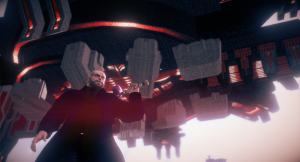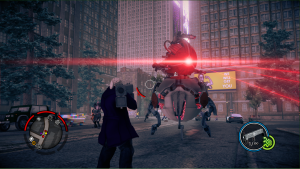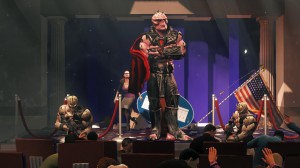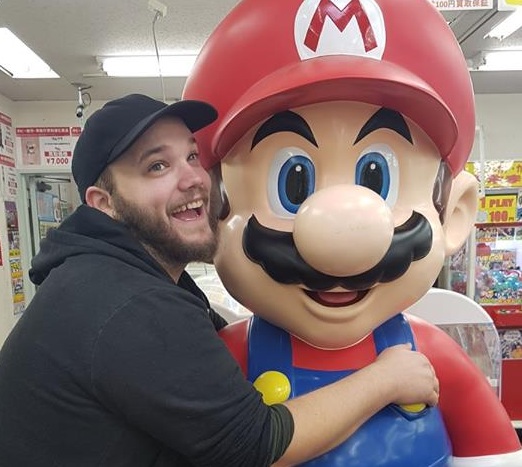
Oh boy, oh boy! I’ve been a huge fan of Saints Row since the very first game, and I’ve been hanging out for SR:IV since the very last moment of Saints Row The Third. A big staple of the franchise is it’s ever-changing self re-invention, from the GTA-esque “gangland sim” style that was present in the first game to the over-the-top parody conventions which were ever-present in the third game, and SR:IV hasn’t decided that it’s above doing the same. The games insistence on flying in the face of decency has landed it in hot water, here in Australia and overseas, mostly due to the use of narcotics during one stage of the game giving your powers a boost, and the addition of a high-powered dildo weapon (which is only available in DLC) called the “probinator”.
Steeped in controversy, this title has gone beyond just poking fun at the genre that it emulates and has literally aimed for the stars, dragging them back down to Earth, bringing a few aliens and some new sex-toys along for this cranked-out ride. However, all that glitters isn’t gold for the latest in the franchise as the new ground that it’s treading has brought with it some significant speed bumps, and I’m sad to say that this game is most certainly not a perfect title. So while this is among the most entertaining games that I’ve played this year, that praise comes with a significantly large grain of salt. It’s also interesting to note that the writers appear to have taken the premise of this game directly from the opening and closing segments of Saints Row The Third, so make of that what you will.
Whilst similarities have often been drawn between this series and Grand Theft Auto, it’s important to remember that Saints Row is a parody of the gangland genre. And yet, whilst It’s interesting to note the parallels, each GTA game has grown more serious whilst the Saints turn increasingly unrealistic and ridiculous. However, there has always been one constant theme throughout the Saints Row series: No matter your standing prior to the beginning of each game, you always end up starting out as the underdog. Starting out as a recruit in a small gang on the streets, the main character ends up in a coma and has to piece together, and lead a shattered gang in taking over a city that had all but forgotten them. This leads to the Saints becoming celebrities that forgot their origins, suffer for it, and go back to their roots to save themselves and dominate a whole new city in the process.
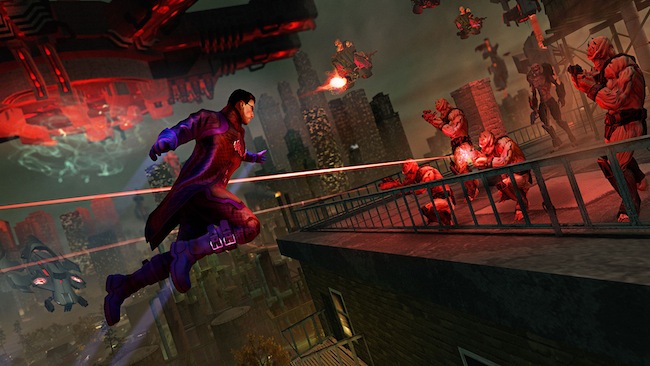
So even when they start out the bottom, no matter what they lose along the way, the Saints land on their feet at the end in a much better position than they were when they started. However, when Saints Row IV starts out by handing players the presidency of the United States of America, it was (briefly) difficult to work out exactly what was coming to kick you to the floor a fourth time until aliens invade to abduct your character and their entire cabinet. The technology of the Zin Empire surpasses that of mankind’s so far that they easily imprison you and your crew within your own little virtual jail cells; at this point you’d be totally doomed if it weren’t for Kinzie, your fiery-haired techno-sage, Jeff Goldbluming her way into the Zin system to help you out. Believe it or not, the setup for the game actually requires the least amount of “suspension of disbelief” in order to reach the end of the game before thinking that perhaps Volition might have been phoning it in on the story, just a little.
The series has never really been known for telling the most deep or meaningful of stories, but Saints Row IV is the first to have at least tried to do so; it fills its narrative with references to it’s predecessors, giving long time fans cause to stop, even if for just a moment, to reflect on both how far the games have come, and their own journey through them. The game keeps revisiting some of the most pivotal moments from past titles, which the player character actively reflects on as the story progresses, uncovering more skeletons in the gangs closet than Wayne Gacey’s rumpus room. If you’re a fan of the series, which to understand most of what happens you would need to be, there are even a few moments that will be immensely satisfying to watch for the way that they handle old plot points and loose ends. This all doesn’t happen without the trademark humor, which often shatters the fourth wall and borders on lunacy, giving the impression that the writers gave a group of children equal parts sugar and whiskey before collaborating with them on the storyboarding.
Despite its occasional low-brow humor, with a healthy dose of pop-culture referencing, unusual setting and back story, the game also manages to maintain a semi-serious tone throughout by motivating the player with the thirst revenge for things and people lost to the attacking alien menace. The entire over-arching plot of Saints Row might be down-right silly to its gooey, delicious core, but the characters themselves have been designed and developed to be either genuinely endearing or absolutely worthy of our scorn, and this makes it easy for us to feel what the game wants us to feel. When the game handed me almost god-like super-powers and said “use these to go rescue your friends”, I didn’t question why they were present in a gangland-sim or even a parody of one, I scaled the nearest building and launched myself screaming, swinging a giant dildo bat, into the fray to be a god damned hero because that’s what I wanted to be to the characters I was supposed to be leading.
Even though I have drawn the comparison in this very article, to call Saints Row IV a sandbox-gangland game and leave it at that would not be doing it justice; the designers have tried to cram as many genres into one game as possible, with the result being that you jump from the main city area into text-based adventures, top down shooters, platformers, as well as a few other game styles. These other visits to what can feel like entirely different games are secluded to areas outside of the city that the bulk of the game takes place in, and they’re still entertainingly brief and relevant to the story that I didn’t mind when they cropped up. So rather than feeling like I was being jarringly snapped back and forth between the main game and these side-genre’s, the design had set them up in such a way that I knew when to expect them and didn’t feel as though I was uncontrollably being dragged into something awful so the game could do something unspeakable to me.
Setting out to improve on existing game mechanics in a sequel is a fantastic endeavor, one to be encouraged in modern games, but Saints Row IV is overzealous in the way it tries to improve on certain things and winds up making others redundant in the process. You’re given the vehicle delivery ability within the first ten minutes of gameplay, except now you can instantly spawn them wherever you are, and you can “save” them by holding down a button instead of having to drive them back to a garage. This was something that you didn’t get in the previous games until a little later on, sort of a milestone in your progress through the game, so to me this indicated that it’s early presence meant something grander was in store later on. Unfortunately, SR:IV’s idea of “later on” is five minutes, and “something grander” meant making vehicle delivery completely superfluous.
The super powers, which are given to you in the first few missions into the story, render any vehicle useless, despite the game still trying to force you to use them in many of the missions. Even though they’re a lot of fun to use, it feels like the game remembered to put the cart before the horse but gave the cart the ability to fly, shoot lasers from its wheels, and question why the horse was even needed in the first place. The roller-coaster of super-powered fun is brought to a grinding halt and hurls you from roof top to roof top collecting “clusters”, bits of loose data in the simulation, which are used to upgrade your new-found abilities. There are over a thousand of them and the process of collecting them isn’t just “like” Crackdown, it’s as if the Zin have reached into our own universe and uploaded a Crackdown sub-routine into the simulation.
This is something which happens often throughout SR:IV, deciding that lampooning GTA wasn’t enough and decided to expand it’s repertoire of funny-making to quite a number of other titles. Unfortunately, it hasn’t mastered the art of parody when it comes to anything outside of GTA, and instead unabashedly tears mechanics straight from other games and thrusts them into itself like some kind of Frankenstein’s monster that’s fixated on dick jokes. Instead of buying shops now, you hack them using the pipe-puzzle sections from Bioshock; at the beginning of the game, you sneak around like Sam Fisher and slit the throats of terrorists; you even have to hide under a cardboard box, a la Metal Gear Solid, sneaking past guards to get to the next area. Having references to other gaming moments isn’t necessarily a bad thing, but re-creating those moments exactly isn’t a reference, it’s stealing, and having too many of them comes across as trying too hard to appeal to too wide an audience.
Controlling the super speed and jumping when I first got them, and with each subsequent upgrade, took some time getting used to, and for the sheer amount of times that I sailed face first into a wall when I had only meant to jump across a short gap, it makes me feel as though perhaps this game could have benefited greatly from destructible environments. Once you do have a good grip on the way they work though, using them to get around the city makes everything a whole lot more fun than having to drive around, even if it makes the map feel a little small. This can lead to some frustrating, if hilarious, situations where the physics causes you to crash into random objects in ways that they probably shouldn’t, like when a lamp pole is flung into the air as your run past it only to have the thing smash into the back of your skull mid-jump and causes you to bomb to the ground.
Shortly into the game, however, it discovers that it messed up the pacing and figures that perhaps you should have done something to earn these deity-like powers it’s given you; it finds ways to make you prove yourself worthy of them as though it’s forgotten that it almost entirely centered itself around them, and you’ve been free-loading off of it this whole time. This is accomplished by taking the powers away from you before you’re flung face first into an absurdly large group of enemies, or lumping you with homies that haven’t jumped on the super-power band-wagon yet, forcing you to cart them around in a car which you’ve spent most of the game un-learning to use. When you aren’t being cuckolded by deus-ex machina, however, the city is your oyster, one that you tear open with unholy strength and fill with enough energy blasts to make Ryu blush. If ground-pounding civilians into the air before you telekinetically toss them into the ocean is wrong, then I don’t want to be right.
I certainly can’t blame Saints Row for not having much to do, as while the story doesn’t last very long it makes up for it by stuffing the hub world full of side missions and collectibles. The side missions especially take up a lot of time since even though you can still run about the city and play them whenever you feel like, the rewards that you reap from performing them can only be obtained after you return to the ship which is outside of the simulation. All of the rewards are just upgrades to your abilities, or new outfits and weapons for you to try out, all of which take place inside of the simulation; seeing as the game makes it abundantly clear that your character has the loosest possible mental grasp over the in-game technology, by having every character repeat lines of dialogue in moron-speak at your behest, I have to question why it’s even necessary to physically be there to pick it up instead of simply having it uploaded to your avatar.
The side missions are certainly fun but there’s very little that’s new, with most of them being the same things from all previous Saints Row game but with a super-powered twist. The “Blazing” missions are now just “Blazin'” and have you running around on foot with speed boosting; Mayhem now gives you a large range of weapons and vehicles to use, including black hole forming rifles, telekinetic powers, and bi-pedal mechs (though once you obtain the “hurricane” upgrade to your super speed ability, all of these additions are rendered moot); and the Professor Genki missions, unquestionably my favorite part of Saints Row The Third, is now less fun as the challenge is diminished somewhat by the fact that you’re practically a God in the system. What have been introduced as completely new missions, however, are the rift segments which consist of platforming levels, shooting galleries that utilise your telekinesis, and sometimes a combination of the two, which was good because prior to that I thought that SR:IV was turning into a “best of” for the series.
Visually, there’s nothing wrong with SR:IV, so while it isn’t photo-realistic it does have it’s own style that has been slowly refined over the series life-time, something which works quite well to at least portray everything clearly. The biggest problem for me was that while the city was still unmistakably Steelport, with the same layout as the previous game to keep you grounded and remind you of where you were, it didn’t do quite enough to sell the idea that you were in a simulated world. The few things it did throw in, like having land-marks and icons reshaped into the image of the Zin or having the NPC models spaz out and change shape or colour, weren’t really used to great effect. The crazy vibe that Saints Row has now become known for actually meant that it either needed to keep these bizarre happenings as an irregular, over-the-top occurrence, or have them everywhere and all the time, because “middle ground” isn’t really fitting in a setting like this.
When it did use visuals to convey the impression of being in a virtual reality, it relied on cheesy effects like having “glitch graphic” textures on the sky box or water surfaces, or the sky around you would appear as a Tron-like grid while the sky textures were being loaded, these few moments were fleeting at best which made the whole thing feel like watered down cyberpunk. The music and radio skits, which played a large part in the previous games, didn’t have nearly an important role this time around, since you’re never really in the car to hear them. There were allusions to the fact that the NPC’s around you were aware that they were in a simulation which gave a few glimpses into the back-story that was poignant and funny, but I hadn’t even thought about the rest until right near the end, realising that the game had probably lost half of it’s atmospheric build-up because of a design flaw, something which was otherwise lacking in the time in-between missions.
 Super-powers are awesome
Super-powers are awesome Hilarious dialogue
Hilarious dialogue Lots of content
Lots of content Diverse, cohesive gameplay
Diverse, cohesive gameplay Great character development
Great character development Abilities can be hard to control
Abilities can be hard to control Short story campaign
Short story campaign Over-used side missions
Over-used side missions Redundant gameplay mechanics
Redundant gameplay mechanics Too many pop-culture references
Too many pop-culture references
At the beginning of this review, I stated that I am a massive fan of the Saints Row series, and for all of it’s flaws, the latest installment hasn’t changed that. In fact, it was still immensely fun to play! The design certainly has it’s problems, the narrative was so far “out there” that you needed binoculars to catch the important moments, and the background world building left something to be desired. However, when bringing all of these elements together, there’s a lot to be said for what you project into the game from your own thoughts. I played a rough approximation of the same character I’ve played through all four games (that’s his jolly mug that’s appeared in all of the screenshots you’ve seen throughout this review), and in a way that made the game feel like it was more than just what was handed over by the development team: it was the next chapter of the same journey I’ve been on since the very first game. It gave the game a very personal touch over-all, especially when you begin to delve into the past of your character, which is more than I can say for many other titles I’ve played recently.

